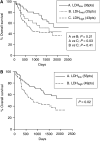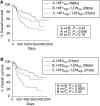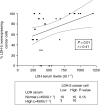Lactate dehydrogenase-5 (LDH-5) overexpression in non-small-cell lung cancer tissues is linked to tumour hypoxia, angiogenic factor production and poor prognosis
- PMID: 12942121
- PMCID: PMC2394471
- DOI: 10.1038/sj.bjc.6601205
Lactate dehydrogenase-5 (LDH-5) overexpression in non-small-cell lung cancer tissues is linked to tumour hypoxia, angiogenic factor production and poor prognosis
Abstract
Lactate dehydrogenase-5 (LDH-5) catalyses the reversible transformation of pyruvate to lactate, having a principal position in the anaerobic cellular metabolism. Induction of LDH-5 occurs during hypoxia and LDH-5 transcription is directly regulated by the hypoxia-inducible factor 1 (HIF1). Serum LDH levels have been correlated with poor prognosis and resistance to chemotherapy and radiotherapy in various neoplastic diseases. The expression, however, of LDH in tumours has never been investigated in the past. In the present study, we established an immunohistochemical method to evaluate the LDH-5 overexpression in tumours, using two novel antibodies raised against the rat muscle LDH-5 and the human LDH-5 (Abcam, UK). The subcellular patterns of expression in cancer cells were mixed nuclear and cytoplasmic. In direct contrast to cancer cells, stromal fibroblasts were reactive for LDH-5 only in a minority of cases. Serum LDH, although positively correlated with, does not reliably reflect the intratumoral LDH-5 status. Lactate dehydrogenase-5 overexpression was directly related to HIF1alpha and 2alpha, but not with the carbonic anhydrase 9 expression. Patients with tumours bearing high LDH-5 expression had a poor prognosis. Tumours with simultaneous LDH-5 and HIF1alpha (or HIF2alpha) overexpression, indicative of a functional HIF pathway, had a particularly aggressive behaviour. It is concluded that overexpression of LDH-5 is a common event in non-small-cell lung cancer, can be easily assessed in paraffin-embedded material and provides important prognostic information, particularly when combined with other endogenous markers of hypoxia and acidity.
Figures






References
-
- Aebersold DM, Burri P, Beer KT, Laissue J, Djonov V, Greiner RH, Semenza GL (2001) Expression of hypoxia-inducible factor-1alpha: a novel predictive and prognostic parameter in the radiotherapy of oropharyngeal cancer. Cancer Res 61: 2911–2916 - PubMed
-
- Akakura N, Kobayashi M, Horiuchi I, Suzuki A, Wang J, Chen J, Niizeki H, Kawamura K, Hosokawa M, Asaka M (2001) Constitutive expression of hypoxia-inducible factor-1alpha renders pancreatic cancer cells resistant to apoptosis induced by hypoxia and nutrient deprivation. Cancer Res 61: 6548–6554 - PubMed
-
- Argiris A, Murren JR (2001) Staging and clinical prognostic factors for small-cell lung cancer. Cancer J 7: 437–447 - PubMed
-
- Bacci G, Ferrari S, Bertoni F, Rimondini S, Longhi A, Bacchini P, Forni C, Manfrini M, Donati D, Picci P (2000) Prognostic factors in nonmetastatic Ewing's sarcoma of bone treated with adjuvant chemotherapy: analysis of 359 patients at the Istituto Ortopedico Rizzoli. J Clin Oncol 18: 4–11 - PubMed
-
- Beasley NJ, Leek R, Alam M, Turley H, Cox GJ, Gatter K, Millard P, Fuggle S, Harris AL (2000) Hypoxia-inducible factors HIF-1alpha and HIF-2alpha in head and neck cancer relationship to tumor biology and treatment outcome in surgically resected patients. Cancer Res 62: 2493–2497 - PubMed
Publication types
MeSH terms
Substances
LinkOut - more resources
Full Text Sources
Other Literature Sources
Medical
Miscellaneous

